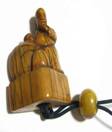|
What is netsuke?
 A netsuke is a
pendant or toggle fastened at the end of a cord attached to a
purse, tobacco pouch, pipe, medicine or seal case (inro), and slung from the
traditional kimono sash (obi). The word “netsuke”
is a combination of two Japanese words: “ne” meaning root, and “tsuke” to
fasten. A netsuke is a
pendant or toggle fastened at the end of a cord attached to a
purse, tobacco pouch, pipe, medicine or seal case (inro), and slung from the
traditional kimono sash (obi). The word “netsuke”
is a combination of two Japanese words: “ne” meaning root, and “tsuke” to
fasten.
Netsuke are miniature objects only about two inches in length. Many of
them are curved and decorated in extremely fine detail. Although Japan
is the home of netsuke, the term is now better known and valued abroad.
History
It is believed that the netsuke was in use in Japan as early as the 14th
century. First the
netsuke was an object of utility and was not considered a work of art. It was a
by-product of larger items of woodcraft.
While skilled artisans were primarily engaged in the sculpture of Buddhist
images, netsuke carvers used waste scraps from the leftover pieces of wood.
Ivory netsuke were also developed as by-products from a great quantity
of plectrums used for the samisen, a stringed instrument of the 17th century.
Netsuke carving reached its zenith late in the 18th century. A number of
skilled artisans sustained a high level of excellence in the craft throughout
the 19th century. The Chinese influence in terms of themes and techniques
during this period was apparent. Following the Meiji Restoration (1867〜),
netsuke have all but disappeared from practical use with the change in
social customs and Westernization of dress in Japan.
Material
The materials used
in netsuke varies a great deal. The most common material used for carving
netsuke was tsuge (boxwood), but other kinds were known to have been utilized
to include black persimmon, mulberry tree, rosewood, white sandalwood, ebony,
quince, camphor wood, other imported woods and ivory.
 
Figure
Of artificial forms, the earliest netsuke were made of slender pieces of
wood and believed to be a single, round and flat. These were commonly known
as “manju.” Since the netsuke is slung from one’s kimono sash, it had to
be small,compact, and three-dimensional with no protruding portions and
two holes used to connecting it to the code. As netsuke gradually developed to
more elaborate forms, their use became widespread during the Edo Period Towards the latter part of the18th century, the gods of Luck, daruma, the
signs of the zodiac, oni or demons, legends, historical events, and foreigners
were used as models for netsuke carving. From the beginning of the 19th
century until the close of the Tokugawa period, animals, birds, reptiles,
vegetables, fruit, utensils, and occupations of daily life were reproduced.
 The various charms attached to the tip of the contemporary cellular phone strap are known to have been adopted from the netsuke concept. The various charms attached to the tip of the contemporary cellular phone strap are known to have been adopted from the netsuke concept.
Gallery
Unlike the art of two-dimensional painting, netsuke is a three-dimensional
object. Viewers can appreciate the object in intricate detail and even
find humor in some netsuke. Since auctions can fetch up to a quarter million dollars for one netsuke,
amateur collectors would be well-advised to consult with reference material,
other collectors and professional if possible, before purchasing. Also,
the rise in netsuke counterfeiting requires complete familiarity before
investing in high-end pieces.
|



 The various charms attached to the tip of the contemporary cellular phone strap are known to have been adopted from the netsuke concept.
The various charms attached to the tip of the contemporary cellular phone strap are known to have been adopted from the netsuke concept.